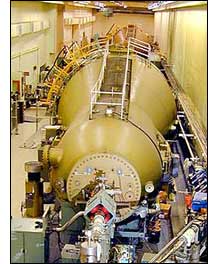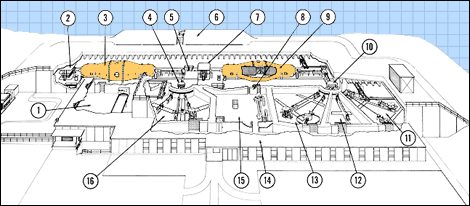Tandem Van de Graaff
 Completed in 1970, the Tandem Van de Graaff
facility was for many years the world's largest electrostatic
accelerator facility. It can provide researchers with beams of more
than 40 different types of ions — atoms that have been stripped of
their electrons. Ions ranging from hydrogen to uranium are available.
The facility consists of two 15 million volt electrostatic
accelerators, each about 24 meters long, aligned end-to-end. Completed in 1970, the Tandem Van de Graaff
facility was for many years the world's largest electrostatic
accelerator facility. It can provide researchers with beams of more
than 40 different types of ions — atoms that have been stripped of
their electrons. Ions ranging from hydrogen to uranium are available.
The facility consists of two 15 million volt electrostatic
accelerators, each about 24 meters long, aligned end-to-end.
To study heavy ion collisions at high energies, a 700 meter-long
tunnel and beam transport system called the Tandem to Booster (TtB) Line
were completed in 1986, allowing the delivery of heavy ions from Tandem to the
Alternating
Gradient Synchrotron (AGS) for further acceleration. At the time,
this
modification opened an entirely new area of research at the AGS.
The TtB now makes it possible for the Tandem to serve as the Relativistic
Heavy Ion Collider's ion source.
One of the new and interesting applications found for the large
variety of different beams and energies available at the Tandem is the
testing of integrated circuit chips under heavy ion bombardment. By
simulating the effects of radiation both in space and on the ground,
scientists and engineers from several other laboratories and companies
are improving the reliability of computers. NASA used the Tandem
in this way to test components of the Mars Pathfinder spacecraft.
 Go to the
Tandem Van de Graaff
Facility website . Go to the
Tandem Van de Graaff
Facility website .
 |
Shown in the above cut-away view of the Tandem Van de Graaff facility are
the two Van de Graaff electrostatic accelerators (3) and (9) each
independently capable of accelerating a wide variety of ion species from
external ion sources (2) and (7) through beam switching magnets (4) and
(10) into target rooms (11), (12), (13) and (16). Highest particle
energies are achieved in three-stage operation with the first
accelerator (3) injecting energetic negative ions through the connecting
link (5) directly into the second accelerator (9). The
accelerators are operated from the centrally located control room (15)
which has direct access to the accelerator rooms through one of the
shielding doors (8). The mechanical equipment room (1) contains
the pumps and compressors necessary to transfer insulating gas from
storage tanks (6) to each accelerator pressure vessel. Laboratory
and office space (14) is available for resident and visiting scientific
personnel. |

Last Modified: February 28, 2008
|



